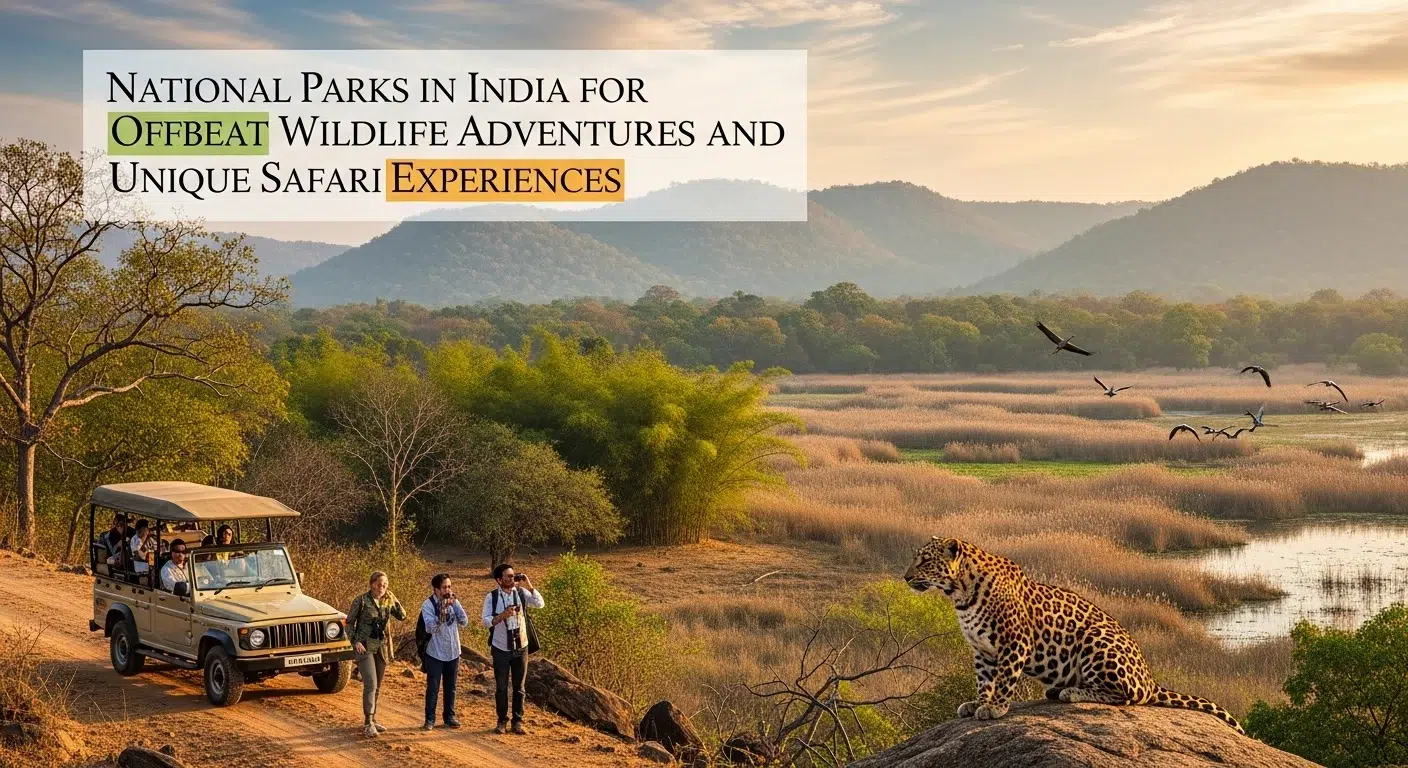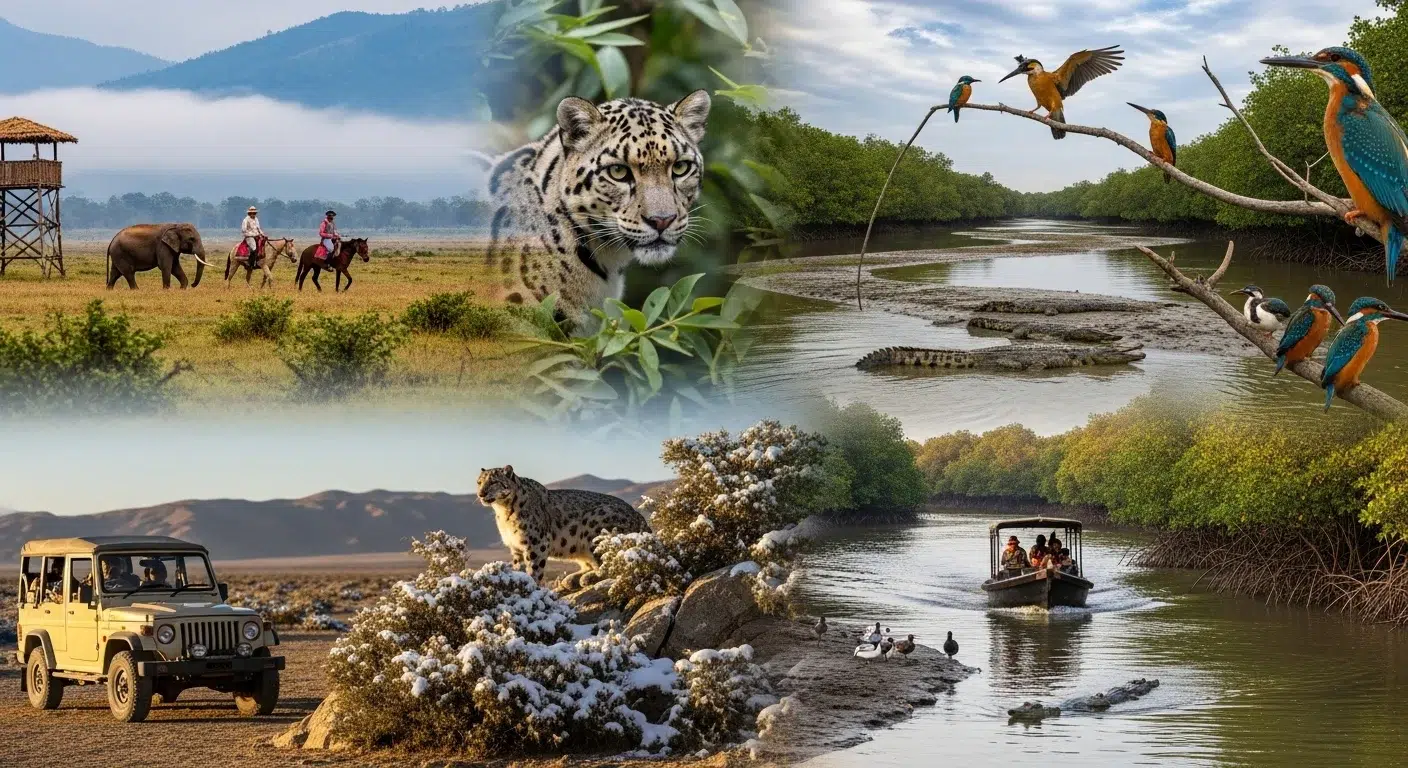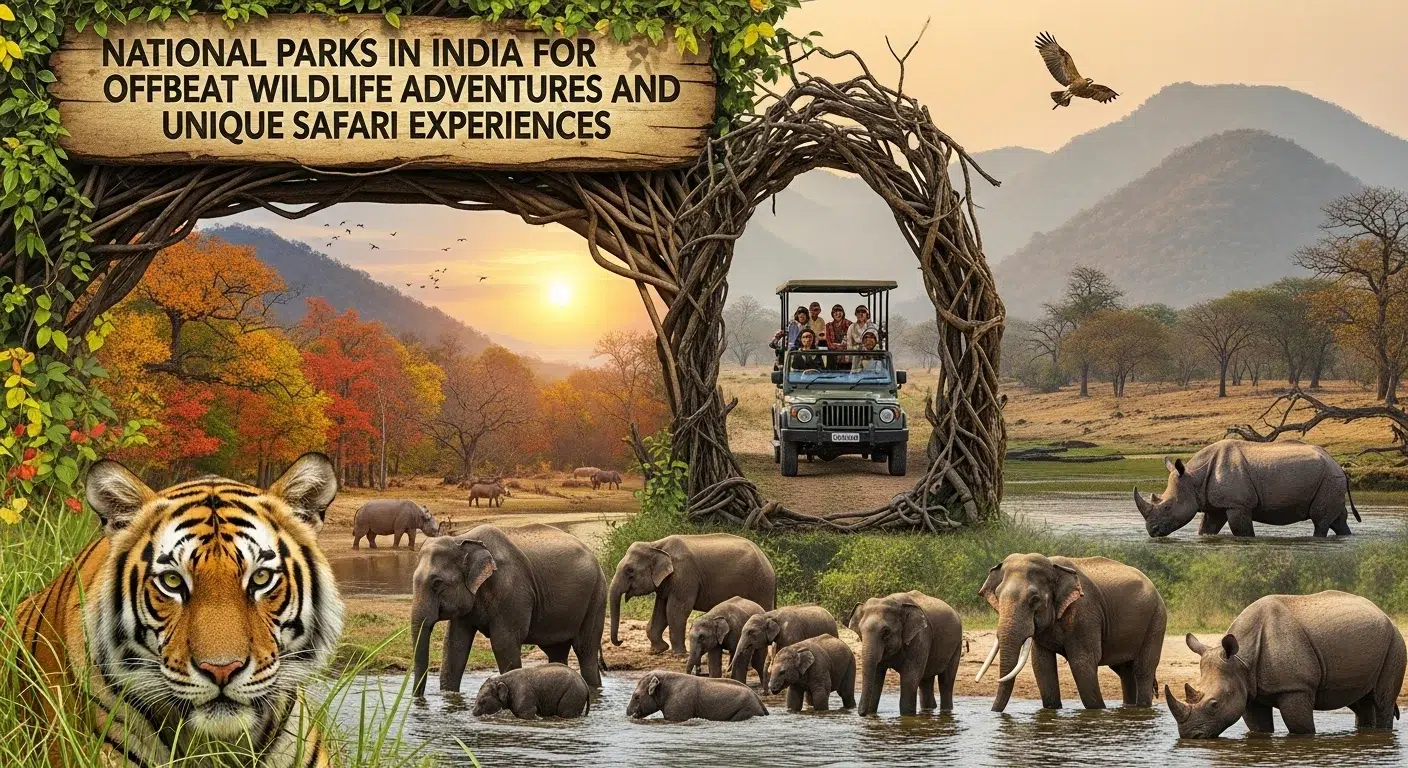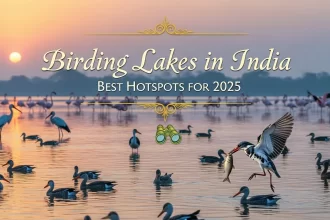India is celebrated for its iconic wildlife destinations like Jim Corbett, Ranthambore, and Kaziranga. Yet beyond these famous names lies a treasure trove of hidden national parks in India that remain largely unexplored. These sanctuaries offer travelers a chance to experience offbeat wildlife destinations India has preserved in their rawest form. From rhino habitats in Assam to rainforests in Kerala, these parks promise unique wildlife experiences India is proud of.
With the 2025 safari season reopening across many reserves and conservation news highlighting rhino protection and rare turtle habitats, this is the perfect time to explore these unexplored national parks India has kept away from mass tourism.
Why Explore Hidden National Parks in India?
- Escape the crowds: Unlike commercialized reserves, these parks offer solitude and untouched wilderness.
- Rare sightings: From red pandas in Sikkim to olive ridley turtles in Odisha, travelers can encounter rare animals in India.
- Eco-tourism in India: Visiting these parks supports conservation and local communities.
- Adventure travel in India: Jungle trekking, river safaris, and birdwatching make these destinations ideal for thrill-seekers.
15 Hidden National Parks You Must Visit

1. Namdapha National Park, Arunachal Pradesh
Nestled in the Eastern Himalayas, Namdapha is a biodiversity hotspot India treasures. It is one of the few places where snow leopards, red pandas, and clouded leopards coexist. Jungle trekking India enthusiasts often choose Namdapha for its rugged trails and dense forests.
- How to Reach: Nearest airport is Dibrugarh (Assam), then a 4–5 hr drive.
- Best Time: October to March for trekking and wildlife spotting.
- Tips: Special permits required; carry warm clothing and hire local guides.
2. Dudhwa National Park, Uttar Pradesh
Located on the Indo-Nepal border, Dudhwa is known for its rhino reintroduction program. It is among the lesser-known tiger reserves India has preserved, offering sightings of swamp deer and tigers.
- How to Reach: Nearest railhead is Dudhwa (via Lucknow).
- Best Time: November to April.
- Tips: Book safaris in advance; combine with Kishanpur and Katarniaghat sanctuaries.
3. Khangchendzonga National Park, Sikkim
A UNESCO World Heritage Site, this park is home to snow leopards and Himalayan black bears. It is also a paradise for wildlife photography India lovers, with breathtaking mountain backdrops.
- How to Reach: Fly to Bagdogra, then drive to Yuksom.
- Best Time: March–May and September–November.
- Tips: Trekking permits required; acclimatize for high altitude.
4. Balpakram National Park, Meghalaya
Often called the “Land of Spirits,” Balpakram is rich in myths and legends. Its gorges and caves make it a hub for adventure travel in India, while its forests shelter elephants and rare medicinal plants.
- How to Reach: Nearest airport is Guwahati, then 6–7 hr drive.
- Best Time: October to March.
- Tips: Carry cash (limited ATMs); explore caves and gorges with local guides.
5. Indravati National Park, Chhattisgarh
Known for freshwater turtles and crocodiles, Indravati is gaining attention in latest news for its turtle conservation efforts. It is also home to wild buffalo and leopards.
- How to Reach: Jagdalpur is the nearest town.
- Best Time: December to March.
- Tips: Entry permits required; best explored with forest department assistance.
6. Bhitarkanika National Park, Odisha
This mangrove paradise is famous for saltwater crocodiles and olive ridley turtles. It is one of the best places for birdwatching in Indian national parks, with migratory species flocking here each winter.
- How to Reach: Nearest railhead is Bhadrak; boat rides from Khola or Gupti.
- Best Time: October to March.
- Tips: Book boat safaris early; carry binoculars for birdwatching.
7. Orang National Park, Assam
Nicknamed “Mini Kaziranga,” Orang boasts the highest density of rhinos after Pobitora. It is a rising star among best wildlife safari in India destinations.
- How to Reach: Tezpur is the nearest airport (80 km).
- Best Time: November to April.
- Tips: Jeep safaris available; combine with Kaziranga for a longer trip.
8. Pobitora Wildlife Sanctuary, Assam
Though small, Pobitora has the highest rhino density in the world. It is ideal for travelers seeking unique wildlife experiences India offers without the crowds of Kaziranga.
- How to Reach: Just 50 km from Guwahati.
- Best Time: November to March.
- Tips: Ideal for day trips; elephant safaris are popular here.

9. Jaldapara National Park, West Bengal
Known for elephants and rhinos, Jaldapara is also a hotspot for wildlife photography India enthusiasts. Jeep safaris here are gaining popularity among eco-tourists.
- How to Reach: Nearest railhead is Madarihat.
- Best Time: October to May.
- Tips: Book elephant safaris early; great for birdwatching enthusiasts.
10. Kalesar National Park, Haryana
Located in the Shivalik foothills, Kalesar is one of the national parks near Himalayas that remains under the radar. Leopards, sambars, and hornbills thrive here.
- How to Reach: Nearest city is Yamunanagar (40 km).
- Best Time: October to March.
- Tips: Carry ID for entry; combine with Morni Hills for a weekend trip.
11. Sundarbans (Lesser-Known Zones), West Bengal
While the Sundarbans are famous for tigers, its lesser-visited zones are rich in estuarine wildlife and turtles. These areas highlight untouched wilderness India still protects.
- How to Reach: Accessible via boat from Godkhali (near Kolkata).
- Best Time: November to February.
- Tips: Explore quieter zones like Sajnekhali; book government lodges early.
12. Kanger Valley National Park, Chhattisgarh
This park combines caves, waterfalls, and tribal culture. It is a hidden gem for eco-tourism in India, offering both natural and cultural exploration.
- How to Reach: Nearest town is Jagdalpur.
- Best Time: October to March.
- Tips: Visit Kotumsar caves and Tirathgarh waterfalls; permits required.
13. Silent Valley National Park, Kerala
A pristine rainforest, Silent Valley is home to the endangered lion-tailed macaque. It is one of the most unexplored national parks India has preserved in its purest form.
- How to Reach: Nearest airport is Coimbatore (65 km).
- Best Time: December to April.
- Tips: Entry is limited; book permits in advance through the forest office.
14. Nokrek National Park, Meghalaya
A UNESCO Biosphere Reserve, Nokrek is known for red panda habitats and rich biodiversity. It is a must-visit for biodiversity hotspots India travelers.
- How to Reach: Nearest town is Tura (45 km).
- Best Time: October to May.
- Tips: Carry trekking shoes; visit the Nokrek Biosphere Reserve interpretation center.
15. Eravikulam National Park, Kerala
Famous for the Nilgiri Tahr, Eravikulam recently made headlines with its 2025 census results. It is also a paradise for wildlife photography India and trekking enthusiasts.
- How to Reach: Nearest town is Munnar (13 km).
- Best Time: September to February.
- Tips: Closed during monsoon (Feb–Mar for Nilgiri Tahr calving season); book tickets online.
Must Read: 18 Most Dangerous Hiking Trails in National Parks Across The Globe That Only True Adventurers Can Conquer
Latest News & Conservation Highlights
- World Rhino Day 2025: Assam’s Orang and Pobitora featured prominently for their rhino density.
- Rare Turtle Habitats: Bhitarkanika and Indravati spotlighted for olive ridley and freshwater turtle conservation.
- Safari Season Reopening (Oct 2025): Many parks, including Dudhwa and Jaldapara, reopened after monsoon closures.
- Nilgiri Tahr Census 2025: Eravikulam reported a healthy rise in population, boosting conservation success stories.
Travel Tips for Offbeat Wildlife Adventures
- Best months: Post-monsoon (October–March) is ideal for safaris.
- Eco-friendly travel: Support local guides, avoid plastic, and respect park rules.
- Photography tips: Early mornings and evenings offer the best light for wildlife photography India.
- Permits & safety: Some parks like Namdapha and Khangchendzonga require special permits.
Conclusion
India’s hidden national parks in India are more than just travel destinations they are living museums of biodiversity. From lesser-known tiger reserves India to untouched wilderness India, these sanctuaries offer travelers a chance to witness nature in its purest form. Exploring them not only fulfills the desire for offbeat wildlife destinations India but also contributes to eco-tourism in India and long-term conservation.
For those seeking unique wildlife experiences India has to offer, these 15 parks are the perfect starting point for an unforgettable journey.
Frequently Asked Questions (FAQs)
Q1. Which is the most unexplored national park in India?
Ans: Namdapha National Park in Arunachal Pradesh is often considered the most unexplored due to its remote location, dense forests, and rare species like red pandas and snow leopards.
Q2. What is the best time to visit hidden national parks in India?
Ans: Most hidden national parks are best visited between October and March, after the monsoon season, when safaris reopen and wildlife sightings are more frequent.
Q3. Which lesser-known national park in India is famous for rhinos?
Ans: Orang National Park and Pobitora Wildlife Sanctuary in Assam are gaining attention for their high rhino density, often highlighted in recent conservation news.
Q4. Are there hidden national parks near the Himalayas?
Ans: Yes, parks like Khangchendzonga (Sikkim) and Kalesar (Haryana) are lesser-known Himalayan gems offering unique trekking and wildlife experiences.
Q5. Which hidden national park is best for birdwatching?
Ans: Bhitarkanika in Odisha and Jaldapara in West Bengal are excellent for birdwatching, with migratory species making headlines during the winter season.
Q6. Do hidden national parks in India require special permits?
Ans: Some parks like Namdapha (Arunachal Pradesh) and Khangchendzonga (Sikkim) require special entry permits due to their sensitive ecological zones and border locations.
Thank you for trusting Outdoorkeeda wildlife adventures as your guide for your travel needs. 🙏







